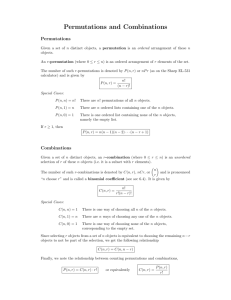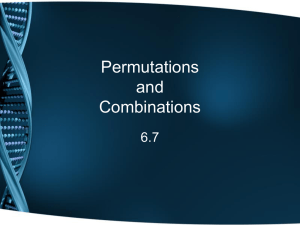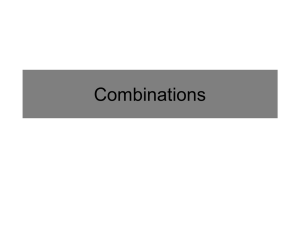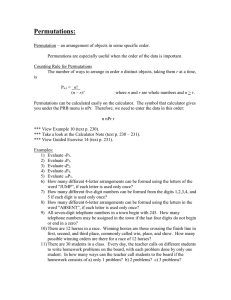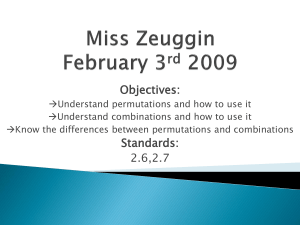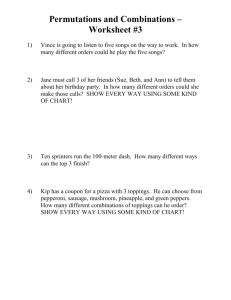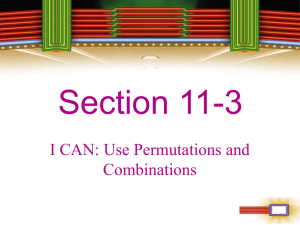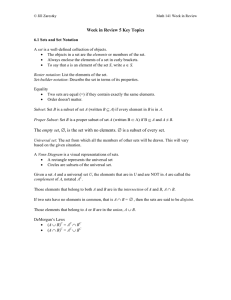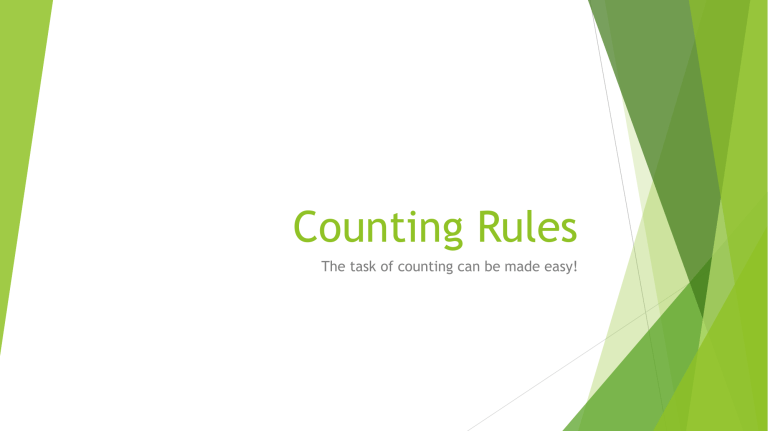
Counting Rules The task of counting can be made easy! Talking Points In this lesson, the following will be our main talking points: Multiplication rule Combinations rule Permutations rule Learning Objectives After completing this lesson and also going through the relevant section in the study guide, the following is expected of you: You should know and be able to use the counting rules. You should also be able to do the calculations both manually and using a calculator. Multiplication Rule If an operation can be performed in n ways, and another operation can be performed in m ways, then either of the two operations can be performed in (m+n) ways. This rule can be extended to any finite number of operations. That is, if one operation can be done in n1 ways, a second one in n2 ways, . . . , a kth one in nk ways, then one of the k operations can be done in n1 + n2 +. . . + nk ways. Example 1 A basic meal consists of soup, a sandwich and a beverage. If a person having this meal has 3 choices of soup, 4 choices of sandwiches and a choice of coffee or tea as a beverage, how many such meals are possible? Solution Choosing soup (taken as operation 1) has 3 possibilities. Choosing a sandwich (taken as operation 2) has 4 possibilities. Choosing a beverage (taken as operation 3) has 2 possibilities. Therefore, the number of choices of meal is equal to 3 × 4 × 2 = 24, according to the multiplication rule. Example 2 A PIN to be used at an ATM can be formed by selecting 4 digits from the digits 0, 1, 2, . . . , 9 . How many choices of PIN are there if digits may not be repeated? Solution Choosing first digit (taken as operation 1) has 10 choices, second digit (taken as operation 2) has 9 choices, third digit (taken as operation 3) has 8 choices, and fourth digit (taken as operation 4) has 7 choices. Therefore, the number of choices of 4-digit pin is 10 × 9 × 8 × 7 = 5040, according to the multiplication rule. Permutations and Combinations Note the difference! Permutations A permutation is the number of different arrangements of a group of items where order matters. The number of permutations of 𝑛 objects taken 𝑟 at a time is calculated using the formula below (Permutations formula) 𝑛𝑃𝑟 = 𝑃 𝑛, 𝑟 = 𝑛! 𝑛−𝑟 ! , with symbol 𝑃 meaning Permutations and parameters 𝑛, 𝑟 as defined above. Combinations A combination is the number of different selections of a group of items where order does not matter. The number of combinations of a group of 𝑛 objects taken 𝑟 at a time is calculated using the formula below (Combinations formula): 𝑛𝐶𝑟 = 𝐶 𝑛, 𝑟 = 𝑛! 𝑟! 𝑛−𝑟 ! , with symbol 𝐶 meaning Combinations and parameters 𝑛, 𝑟 as defined above. Example 1 Four people (A, B, C, D) serve on a board of directors. A chairman and vice-chairman are to be chosen from the four people. In how many ways can this be done? Answer: Number of ways is 12. As see below is a list of all possible selections of two people (the chairman and vice-chairman) from four people. Example 2 Suppose that the two people to be selected from four people (A, B, C, D) are to serve a specified similar role. In how many ways can this be done? Answer: Number of ways = 6. As seen below is a list of all possible selections of two people from four people People chosen A and B A and C A and D B and C B and D C and D Application of formulae In example 1, the Permutations formula applies with 𝑛 = 4, 𝑟 = 2. Thus, number of ways = 𝑃 4,2 = 4! 4−2 ! = 12. In example 1, the Combinations formula applies with 𝑛 = 4, 𝑟 = 2. Thus, number of ways = 𝐶 4,2 = 2! 4! 4−2 ! = 6. N.B. In both cases, a choice of 2 people from 4 people is made. However, in case 1, the order of choice of 2 people does matter (since the one person chosen is chairman and the other one vice-chairman). In case 2, the order of choice of 2 people does matter. In this case, the only interest is in who serves on the committee. Hence, there are more permutations than combinations. Exercise Find the number of ways to take 4 people and place them in groups of 3 at a time where order does not matter. Use your calculator You must study the calculator instructions notes on how to use a calculator and you can be able to do these calculations using your calculator.
